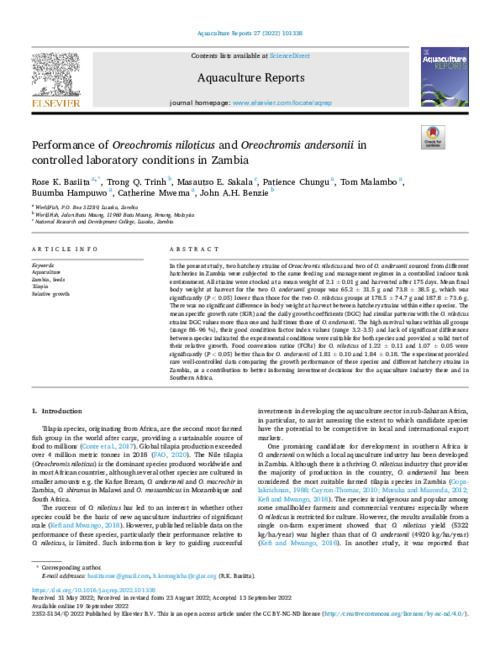Please use this identifier to cite or link to this item:
https://hdl.handle.net/20.500.12348/5361
Performance of Oreochromis niloticus and Oreochromis andersonii in controlled laboratory conditions in Zambia
| dc.creator | Komugisha, B. | en_US |
| dc.creator | Trinh, T.Q. | en_US |
| dc.creator | Sakala, M. | en_US |
| dc.creator | Chungu, P. | en_US |
| dc.creator | Malambo, T. | en_US |
| dc.creator | Hampuwo, B. | en_US |
| dc.creator | Mwema, C.M. | en_US |
| dc.creator | Benzie, J. | en_US |
| dc.date.accessioned | 2023-01-10T13:23:13Z | |
| dc.date.available | 2023-01-10T13:23:13Z | |
| dc.date.issued | 2022 | en_US |
| dc.identifier.citation | Basiita Rose Komugisha, Trong Trinh, Masautso Sakala, Patience Chungu, Tom Malambo, Buumba Hampuwo, Catherine Mwema, John Benzie. (1/12/2022). Performance of Oreochromis niloticus and Oreochromis andersonii in controlled laboratory conditions in Zambia. Aquaculture Reports, 27. | en_US |
| dc.identifier.issn | 2352-5134 | en_US |
| dc.identifier.uri | https://hdl.handle.net/20.500.12348/5361 | |
| dc.description.abstract | In the present study, two hatchery strains of Oreochromis niloticus and two of O. andersonii sourced from different hatcheries in Zambia were subjected to the same feeding and management regimes in a controlled indoor tank environment. All strains were stocked at a mean weight of 2.1 ± 0.01 g and harvested after 175 days. Mean final body weight at harvest for the two O. andersonii groups was 65.2 ± 31.5 g and 73.8 ± 38.5 g, which was significantly (P < 0.05) lower than those for the two O. niloticus groups at 178.5 ± 74.7 g and 187.8 ± 73.6 g. There was no significant difference in body weight at harvest between hatchery strains within either species. The mean specific growth rate (SGR) and the daily growth coefficients (DGC) had similar patterns with the O. niloticus strains DGC values more than one and half times those of O. andersonii. The high survival values within all groups (range 86–96 %), their good condition factor index values (range 3.2–3.5) and lack of significant differences between species indicated the experimental conditions were suitable for both species and provided a valid test of their relative growth. Food conversion ratios (FCRs) for O. niloticus of 1.22 ± 0.11 and 1.07 ± 0.05 were significantly (P < 0.05) better than for O. andersonii of 1.81 ± 0.10 and 1.84 ± 0.18. The experiment provided rare well-controlled data comparing the growth performance of these species and different hatchery strains in Zambia, as a contribution to better informing investment decisions for the aquaculture industry there and in Southern Africa. | en_US |
| dc.format | en_US | |
| dc.language | en | en_US |
| dc.publisher | Elsevier | en_US |
| dc.rights | CC-BY-NC-ND-4.0 | en_US |
| dc.source | Aquaculture Reports;27,(2022) | en_US |
| dc.subject | relative growth | en_US |
| dc.title | Performance of Oreochromis niloticus and Oreochromis andersonii in controlled laboratory conditions in Zambia | en_US |
| dc.type | Journal Article | en_US |
| cg.contributor.funder | African Development Bank | en_US |
| cg.contributor.funder | Government of Zambia | en_US |
| cg.coverage.country | Zambia | en_US |
| cg.coverage.region | Eastern Africa | en_US |
| cg.subject.agrovoc | aquaculture | en_US |
| cg.subject.agrovoc | feeds | en_US |
| cg.subject.agrovoc | zambia | en_US |
| cg.subject.agrovoc | tilapia | en_US |
| cg.subject.agrovoc | Fish | en_US |
| cg.contributor.affiliation | WorldFish | en_US |
| cg.contributor.affiliation | Natural Resources Development College | en_US |
| cg.contributor.affiliation | Department of Fisheries | en_US |
| cg.identifier.status | Open access | en_US |
| cg.identifier.ISIindexed | ISI indexed | en_US |
| cg.contribution.worldfishauthor | Komugisha, B. | en_US |
| cg.contribution.worldfishauthor | Trinh, T.Q. | en_US |
| cg.contribution.worldfishauthor | Chungu, P. | en_US |
| cg.contribution.worldfishauthor | Malambo, T. | en_US |
| cg.contribution.worldfishauthor | Hampuwo, B. | en_US |
| cg.contribution.worldfishauthor | Mwema, C.M. | en_US |
| cg.contribution.worldfishauthor | Benzie, J. | en_US |
| cg.description.theme | Sustainable aquaculture | en_US |
| dc.identifier.doi | https://dx.doi.org/10.1016/j.aqrep.2022.101338 | en_US |
| cg.creator.id | Basiita Rose Komugisha: 0000-0002-7257-0286 | en_US |
| cg.creator.id | Catherine Mawia Mwema: 0000-0001-8015-5747 | en_US |
| cg.creator.id | John Benzie: 0000-0001-9599-8683 | en_US |
Files in this item
This item appears in the following Collection(s)
-
Sustainable aquaculture [2735]
